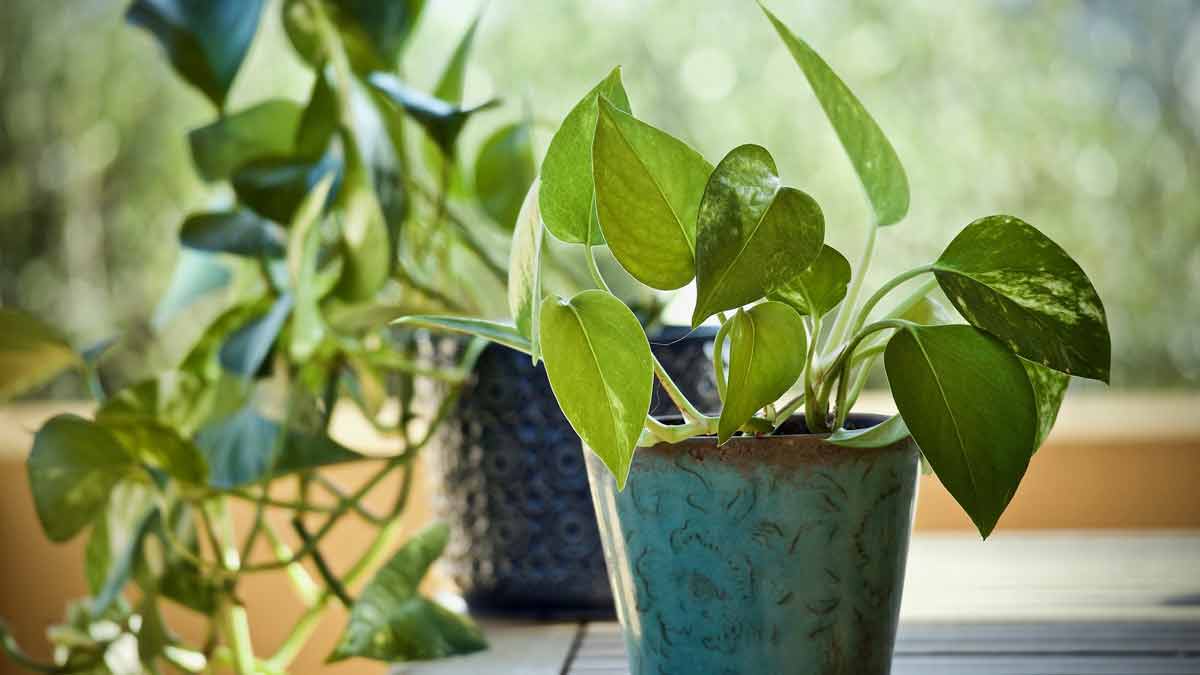For a healthy Pothos plant, place it in bright indirect light (avoiding direct sunlight to prevent leaf burns), water every 1-2 weeks with well-draining soil, maintain 50-70% humidity, and keep the temperature within 65°F-85°F.
It’s no secret that indoor plants can add vitality and color to your living spaces, but maintaining their health often seems like a mystery.
Luckily, the resilient Pothos plant, with its draping vines and heart-shaped leaves, is one green secret that’s easy to unravel even for beginners.
As you read on, you’ll discover essential tips and practices to keep your Pothos plant thriving indoors, converting your home into a luscious urban garden.
With the right care, not only will it thrive, but it will surprise you with its versatility and tenacity in adorning various corners of your home. Dust off those green thumbs and get ready to grow!
Facts and Statistics
- According to a study published in the Journal of Horticulture and Forestry, Pothos plants show optimal growth at temperatures between 65°F-85°F, with decreased growth rate at temperatures below 60°F.
- Another research by Botanical Society of America states that Pothos can tolerate humidity levels of 50-70% ideally, although it can adapt to normal or dry air conditions as well.
- A recent survey in 2022 reported that pothos are capable of surviving in varying light levels – from bright, indirect light to medium, and low indirect light. This makes them a suitable houseplant choice for about 75% of households surveyed who have varying degrees of indoor natural lighting conditions.
Essential Care for Pothos Plants
When caring for your beloved Pothos plant, there are a few key factors to keep in mind to ensure its vitality and thriving growth. Let’s dive into the essential care tips for Pothos plants.
First and foremost, let’s talk about watering. Pothos plants enjoy moist soil but can easily suffer from overwatering. Finding the right balance to prevent wilting and root rot is crucial.
To achieve this, water your Pothos thoroughly every 1-2 weeks, allowing the soil to dry out slightly between waterings.
Before watering, always check the top inch of soil and ensure it feels dry. If it’s still moist, hold off on watering until it dries out a bit more. Remember, consistency is key in maintaining healthy hydration levels for your Pothos.
Another significant aspect of Pothos care is lighting. These versatile plants thrive in bright, indirect light but can also tolerate medium to low indirect light conditions.
However, it’s important to note that exposing your Pothos to intense, direct sunlight can lead to leaf burn.
Therefore, finding a well-lit spot near a window with filtered light or further away from a bright sunlit area would be ideal.
Furthermore, humidity plays a role in the overall health of your Pothos plant.
While they can tolerate normal or dry air conditions, providing optimal humidity levels can promote lush growth and prevent leaf browning.
Aim for humidity levels between 50-70% if possible by using methods such as misting the leaves occasionally or placing a tray of water near the plant to increase moisture in the air.
Lastly, let’s talk about temperature preferences. Pothos plants enjoy temperatures ranging from 65°F-85°F (18°C-29°C).
Avoid exposing them to temperatures below 60°F (15°C) as it can stunt their growth and potentially cause damage. When it comes to temperature, consistency is vital to keep your Pothos thriving.
Required Lighting and Humidity Levels
Pothos plants are known for their versatility when it comes to lighting requirements.
While they can adapt to a wide range of light conditions, providing the optimal amount of light will result in more vibrant, lush foliage.
While Pothos can tolerate medium to low indirect light, they thrive best in bright, indirect light. This means placing your plant near a north or east-facing window where it can receive gentle, filtered sunlight throughout the day.
Keep in mind that direct sunlight can be too harsh and lead to scorching or burning of the leaves.
For instance, if you have a Pothos plant placed in a corner away from windows with limited natural light, you may notice its leaves becoming pale or leggy over time.
In this case, consider providing supplemental artificial light using grow lights to ensure adequate brightness for your Pothos.
In addition to proper lighting, maintaining optimal humidity levels is crucial for the health and well-being of your Pothos plant. While they can tolerate normal or dry air conditions, higher humidity levels ranging between 50-70% are ideal.
To increase humidity around your Pothos plant, you can employ various strategies. Misting the leaves with water periodically throughout the week helps create a moist environment for the plant.
Placing your Pothos on a tray filled with water and pebbles also helps create localized humidity around the plant as the water evaporates.
Additionally, grouping several plants together can create a microclimate with increased humidity due to transpiration.
You are setting up the ideal conditions for your Pothos plant to thrive and flourish by providing the required lighting and humidity levels.
Soil Preference
The soil you choose for your Pothos plant plays a vital role in its overall health and well-being.
Pothos plants thrive in a well-draining potting mix that retains some moisture but doesn’t become waterlogged.
To improve drainage, a high-quality, peat-based potting mix with perlite or vermiculite is a good choice.
When selecting a potting mix, it’s essential to avoid heavy garden soil or clay-based mixtures as they tend to retain too much water, leading to root rot and other problems.
You want the soil to be loose and airy, allowing room for the roots to breathe and grow.
One suitable potting mix recipe for Pothos plants includes two parts peat moss, one part perlite, and one part compost. This mixture provides the necessary nutrients, drainage, and aeration that these plants require.
Another aspect to consider is the pH level of the soil. Pothos plants prefer slightly acidic to neutral soil with a pH range between 6.0 and 7.0.
You can use an inexpensive pH testing kit available at garden centers to determine the pH level of your potting mix.
Keep in mind that regular repotting is beneficial for Pothos plants as they outgrow their containers over time. Repotting allows for fresh soil and ensures sufficient space for root expansion.
Aim to repot your Pothos plant every couple of years during spring or summer.
Watering and Fertilization Guidelines
Proper watering is crucial for maintaining healthy Pothos plants.
These plants prefer evenly moist conditions but are susceptible to root rot if left sitting in soggy soil for extended periods. It’s important to strike a balance between overwatering and underwatering.
To determine when to water your Pothos plant, it’s always best to check the soil’s moisture level. Insert your finger about an inch into the soil, and if it feels dry, it’s time to water.
However, if the soil is still slightly moist, it’s better to hold off watering until it dries out a bit more. Remember that Pothos plants can tolerate slight drying out between waterings.
As a general guideline, water your Pothos plant thoroughly, allowing the water to flow through the drainage holes at the bottom of the pot.
Discard any excess water from the saucer or cache pot. Avoid letting your Pothos sit in standing water to prevent root rot.
When it comes to fertilization, Pothos plants are moderate feeders. You can use a balanced, all-purpose houseplant fertilizer diluted to half strength or follow the product instructions for dosage guidelines.
Apply the fertilizer every two to four weeks during spring and summer when the plant is actively growing. In fall and winter, reduce the frequency to once a month or suspend fertilization altogether.
Think of feeding your Pothos plant like providing it with a nutrient boost – just like we need a balanced diet for optimal health, these plants require essential nutrients for lush growth.
With these watering and fertilization guidelines in mind, you’ll be well on your way to keeping your Pothos plant thriving and vibrant.
Advancing Pothos Plant Growth
Pothos plants are known for their rapid growth and the ability to cascade down from hanging planters or trail along shelves.
If you want to take your pothos plant’s growth to the next level and create a lush, green display, there are several practices you can implement.
One key factor in promoting healthy growth is providing the right amount of light. Pothos thrives in bright, indirect light but can tolerate medium to low indirect light as well.
However, intense, direct sunlight should be avoided as it can lead to burned leaves.
By placing your pothos near a window that receives ample indirect light or using artificial grow lights, you can ensure it has the energy needed for vigorous growth.
Proper watering is another crucial aspect of advancing pothos plant growth. Overwatering can result in yellowing leaves and black stems, while underwatering will cause wilting and dryness in the potting mix.
Aim for watering every 1-2 weeks, allowing the soil to dry out between waterings. This balance ensures that the roots receive adequate moisture without becoming waterlogged.
Nutrition plays a vital role in supporting plant growth and overall health.
While pothos plants generally don’t require frequent fertilization, providing them with a balanced houseplant fertilizer during the growing season can give them an added boost.
Follow the instructions on the fertilizer packaging to avoid overfeeding, which could harm the plant.
Imagine treating your pothos plant with care, providing just enough sunlight, watering at regular intervals, and offering it a nutritious meal occasionally.
In return, you’ll witness its vibrant foliage thrive and expand throughout your indoor space.
In addition to optimizing light, water, and nutrients, taking steps for proper maintenance is essential for advancing pothos plant growth.
Regularly dusting off the leaves with a soft cloth or gently rinsing them under a shower helps keep them clean and free from dust, allowing for optimal photosynthesis.
Pruning is another practice that encourages healthy growth in pothos plants.
Trimming back leggy vines or cutting off damaged leaves promotes bushier growth and prevents the plant from becoming sparse.
Moreover, regular pruning allows you to propagate the cuttings, creating new plants to enjoy or share with friends.
Now that we have covered how to advance pothos plant growth through various practices let’s delve into the important aspects of repotting and propagation.
Practices for Repotting and Propagation
At some point in your pothos plant’s journey, it may outgrow its current pot or require refreshing the potting mix. Repotting can provide additional space for root growth and replenish nutrients.
Here are some key practices to keep in mind:
- Choosing the right time: Spring is generally considered an ideal time to repot pothos plants when they enter their active growth phase. Avoid repotting during colder months or when the plant is stressed.
- Selecting a suitable container: Choose a pot that is one size larger than the current one and has drainage holes to prevent waterlogging. This allows for proper airflow and drainage of excess water.
- Preparing the potting mix: Pothos plants prefer well-draining soil mixes such as those containing a combination of peat moss, perlite, and sphagnum moss. This ensures adequate moisture retention without saturating the roots.
- Gently removing the plant: Carefully loosen the root ball by tapping the sides of the pot and sliding it out. Be gentle to avoid damaging delicate roots.
- Inspecting and pruning roots: Examine the roots for any signs of rot or disease, trimming away unhealthy portions if necessary.
- Placing in new soil: Position the pothos plant in the center of the new pot and backfill it with fresh potting mix, ensuring that the crown of the plant remains at the same level as before. Lightly press the soil to stabilize the plant.
Repotting a pothos plant is like giving it a larger home to stretch its roots, allowing it to gather more nutrients and grow even stronger.
Unfavorable Pothos Conditions to Avoid
To keep your Pothos plant thriving, it’s crucial to understand the unfavorable conditions that can hinder its growth.
By avoiding these conditions, you can ensure the health and vitality of your indoor greenery.
One common mistake is exposing Pothos to intense, direct sunlight. While these plants thrive in bright, indirect light, direct sun exposure can actually burn their leaves and cause damage.
To prevent this, place your Pothos in an area with bright, indirect light or provide some shade if necessary.
Another factor to consider is proper watering.
Overwatering can lead to yellowing leaves and black stems, while underwatering will result in wilting and drying of the potting mix.
Watering the Pothos every 1-2 weeks is essential, allowing the soil to dry out between waterings. This will help maintain the proper moisture balance for healthy growth.
Temperature plays a significant role as well. Pothos plants prefer temperatures between 65°F-85°F and should be kept away from temperatures below 60°F.
Extreme cold or hot conditions can stress the plant and impact its overall health. Be mindful of their placement and ensure they’re not exposed to extreme temperature fluctuations.
In addition to lighting, watering, and temperature, humidity levels also affect Pothos plants.
While they can tolerate normal or dry air, aiming for humidity levels of 50-70% will create optimal conditions for their growth. You can increase humidity by placing a tray of water near the plant or using a humidifier.
Lastly, using a well-draining potting mix is vital when planting your Pothos. Excessive moisture retention due to poorly draining soil can lead to root rot and other fungal issues.
Ensure the pot has drainage holes, and choose a high-quality potting mix that provides good drainage.
By avoiding intense sunlight exposure, maintaining proper watering practices, controlling temperature and humidity levels, and using well-draining soil, you can create a favorable environment for your Pothos plant to thrive.
Handling Pothos Health Issues
While Pothos plants are generally considered easy to care for, they can still face health issues from time to time. It’s essential to promptly identify and address these problems to ensure the long-term well-being of your plant.
One common issue is root rot, which occurs due to overwatering or poorly draining soil.
Signs of root rot include yellowing leaves, wilting, and a foul odor emanating from the roots. If you notice these signs, it’s crucial to take action immediately.
Carefully remove the affected parts of the plant and repot it in fresh, well-draining soil. Adjust your watering regimen accordingly to prevent further instances of root rot.
Another problem that Pothos plants may encounter is pest infestation.
Common pests that can affect Pothos include spider mites, mealybugs, and scale insects. These pests can cause discoloration of leaves, webs, or sticky residue on the plant.
To address pest issues, use an appropriate insecticidal soap or neem oil spray. Regularly inspect your plant for any signs of pests and treat them as soon as possible to prevent the infestation from spreading.
Nutrient deficiencies can also impact the health of your Pothos plant.
Yellowing leaves with green veins may indicate a nitrogen deficiency, while pale leaves could indicate a lack of iron.
Fertilize your Pothos plant regularly using a balanced houseplant fertilizer to provide it with the necessary nutrients for healthy growth.
Finally, occasionally check your Pothos for any signs of disease such as fungal infections or leaf spots.
If you notice any unusual symptoms or patterns on the leaves or stems, consult a horticulturist or plant expert who can guide you on the appropriate treatment.
By being vigilant and attentive to your Pothos plant’s health, promptly addressing root rot, pest infestation, nutrient deficiencies, and disease issues, you can ensure its continued vitality and beauty.
Identifying and Addressing Common Problems
Despite their reputation as hardy and low-maintenance plants, Pothos can still encounter a few common problems that may hinder their growth and overall health.
By being vigilant and proactive in identifying and addressing these issues, you can ensure your Pothos plant thrives and remains a beautiful addition to your indoor greenery.
One common problem that Pothos plants may face is overwatering. While keeping the soil moist is important, excessive watering can lead to root rot and yellowing leaves.
To address this issue, allow the soil to dry out between waterings and ensure proper drainage by using a well-draining potting mix.
Another challenge that Pothos plants may encounter is underwatering. Inadequate watering can cause wilting and drying of the potting mix, resulting in stress for the plant.
To remedy this, check the moisture levels of the soil regularly and water thoroughly when needed. It’s essential to strike a balance between underwatering and overwatering to maintain optimal plant health.
Pests are another common problem that may affect Pothos plants. Mealybugs, spider mites, and scale insects can infest the leaves and stems, causing damage and hindering growth.
Regularly inspect your plant for any signs of pests, such as webbing or sticky residue on the leaves. If you identify an infestation, treat it promptly using organic insecticidal soap or neem oil spray.
Light is crucial for the healthy growth of Pothos plants, but excessive exposure to direct sunlight can burn the leaves. On the other hand, insufficient light can result in leggy vines with sparse foliage.
Ensure your Pothos receives bright indirect light for optimal growth. You can place it near a north or east-facing window or use artificial grow lights if natural light is limited.
Temperature fluctuations can also impact Pothos plants.
They thrive in temperatures between 65°F-85°F, with a minimum temperature of around 60°F. Avoid exposing them to extreme cold or drafts caused by open windows or air conditioning vents. Sudden changes in temperature can lead to stress and leaf drop.
Interestingly, Pothos can tell you if something is wrong with their environment through visual cues.
If the leaves start turning yellow, it might indicate excessive watering, direct sunlight exposure, or nutrient deficiencies.
Brown spots could signal fungal diseases or inconsistent watering practices.
By observing the condition of your plant’s leaves and understanding the potential causes, you can address any issues promptly.
For instance, if you notice yellowing leaves, adjust your watering schedule and ensure the plant is receiving adequate light. If brown spots appear, evaluate your watering habits and consider adjusting your humidity levels.
You can maintain a healthy and thriving Pothos plant by being attentive to these common problems and taking appropriate action when necessary.
Remember, each plant is unique and may require slightly different care based on its individual needs.
Final Thoughts
Pothos plant care is a delightful journey into nurturing the lush greenery of these beautiful indoor companions.
With the right balance of light, water, humidity, and temperature, anyone can enjoy a thriving Pothos’s vibrant and cascading foliage.
The key is to strike the perfect harmony in these aspects, avoiding common pitfalls like overwatering, direct sunlight, or neglecting to address health issues promptly.
By following these care guidelines and monitoring your Pothos plant’s condition, you can enjoy a flourishing and resilient indoor garden that brings vitality and beauty to your living spaces.
So, dust off those green thumbs, implement these practices, and watch your Pothos flourish, transforming your home into a luscious urban oasis.








